Tracing consciousness down to the cell
Where is consciousness in the brain? This question has puzzled scientists, physicians, and philosophers alike. Recent work has raised an exciting possibility: we may be able to trace the most complex capabilities of the brain right the way down to the cells.
The brain’s cortex is populated by millions of specialized cells that process all incoming information and generate behavioural output: the pyramidal neurons. But how do these cells make us conscious of what we experience? Intriguingly, recent theories propose that even a single pyramidal neuron may condense the main features of conscious perception. These features refer to the ability to put our perceptions into context. This allows us to choose the right behaviour. Recent work by me and my colleagues uses mathematical models of brain cells to explore how this may happen.
Giant Pyramids
About 150 years ago, the Ukrainian anatomist Betz was the first to glimpse the most conspicuous cell types in the brain. He called them “giant pyramids” because of their pointed silhouette. Since then, the shape of the pyramidal neuron has been noted for its complexity. Just as a house has several rooms, these neurons have several spatial compartments: input terminals – dendrites –, a main body, and an output terminal – the axon. The dendrites are where neurons receive incoming information, but this information may come as a whisper or as a loud shout. If input is weak, it doesn’t have much influence on the neuron’s activity. But if the input is strong enough, the neuron will generate an output response. When neurons respond strongly to a perceived stimulus, this perception will reach the status of a conscious percept.
But as it turns out, the story is not so simple. On the one hand, pyramidal neurons have a preferred sensory input. One group of neurons may have a preference for a certain word; another group a preference for a specific location on a computer screen; and yet another a preference for the face of a dear one. Neurons in the same gang enhance each other’s activity. At the same time, they inhibit other gangs that have different preferences. The input from the preferred gangs arrives close to the body of the neuron in question – this input has a direct route to activate the neuron. So what are the other parts of the input regions for?
Putting things into context
So far we have considered the ability of the pyramidal neuron to integrate a specific word, a point in space, or a face. In general, a neuron will be activated in the presence of its preferred stimulus. However, sometimes it remains silent. The reason is that pyramidal neurons are also sensitive to the context in which information occurs. For example, when we hear a phone ringing, we may quickly open a bag and grab the device… or we may just continue as if nothing has happened. The difference? Whether the phone ringing is ours or our neighbour’s. Even if the ringtones are the same, we will process them differently. Here’s where the contextual information plays a key role. It has been long recognized that the brain has an amazing capability to integrate all kind of contextual information: our bodily needs (I’m hungry), external demands (I have to get to work on time), current state (trains are delayed today), predictions of the future (if I’m late my boss will be very upset), and then produce an output (no time for breakfast today, I’ll just grab a coffee on the way to work). The amazing thing is that this complex process can occur even at the level of a single neuron.
Contextual information arrives at the far end of the neuron’s input area. From there, this information can modulate the way the neuron responds to its preferred stimulus – the one that arrives close to its body. This spatial segregation of information within the neuron has intrigued neuroscientists. One consequence is that not everything that can potentially be processed will actually be processed. In fact, many experiments over the years have shown that only a small percentage of what we actually perceive will reach the status of conscious perception. This has many advantages, because to be conscious of absolutely every single stimulus around us would be extremely costly in terms of energy and time. The key is to focus just on what is relevant - and this is already computed at the level of the individual neuron.
Voices in the brain
This becomes even more interesting if the system is hacked. It could happen that certain sensory content is processed strongly by the neurons and access consciousness, but that in reality that content is not coming from our senses. That’s what happens when we are dreaming. Also, certain mental diseases are associated with what neuropsychologists call altered states of consciousness, such as pathological hallucinations. The hallucinated voices feel very real to patients, but are actually not coming from where they seem to come from. Understanding how input is selected at the level of individual neurons is a first step to understanding how these unusual situations occur. But if the system is so complex, how can we study it?
How can math and computers help us understand the brain?
In a recent article, we explored how different inputs and modulators interact at the level of the neuron to determine whether a neuron activates or not. We built mathematical models that represent the biophysics of the pyramidal neurons. Then we studied the properties of the models with computational tools. We did this by including different parameters representing different factors, and then checked how they affected the capacity of the neuron to activate. These factors included, for example, specific cellular components of the neuron, substances that arrive at the neuron (neuromodulators), or the place of stimulation. Our models were able to reproduce some experimental findings. Furthermore, they showed that the effects of many factors in combination generate a wide range of possible scenarios where neurons have varying sensitivity to incoming stimuli. While these are still the early stages, it opens up the exciting possibility that in the future we will be able to model all the different states of consciousness that a human brain can traverse. Our hope is that we will be able to understand more about how the brain is such a flexible organ, and why it processes information differently in the case of mental illness.





